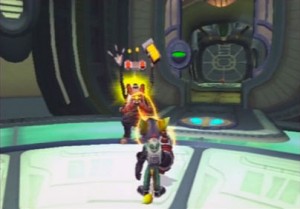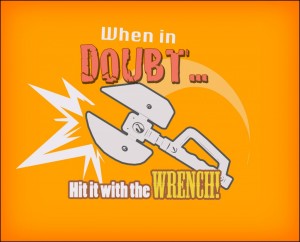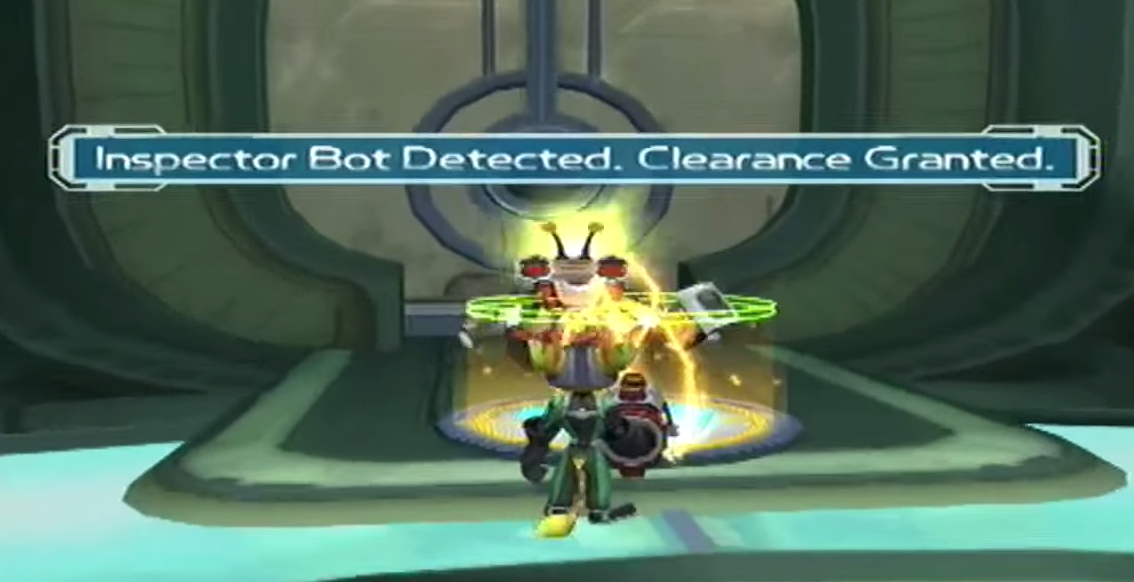A Morality Tale
This week I’m going to tell the story of how I learned one of the most important things I ever learned about game design: As a designer, it is not my job to decide whether my game is fun — it is the players’ job.
When I was still a junior designer working at Insomniac Games, I was given the task of shepherding parts of the game through development. Generally the way this worked is that a more senior designer would come up with a design for a feature on paper. After it was approved by the lead designer and the various other stakeholders, the design would be assigned to a more junior designer whose job it was to make sure the thing got done and done well.
I was working on Ratchet and Clank 2 (Going Commando in the USA) at the time, and I was given the Tractor Beam gadget. I talk about the specifics of that gadget in my Gamasutra article on Depth in Game Mechanics. If you’re not familiar with it, I’ve got a whole description of it there.
Basically it’s a glorified block-pushing (Sokoban) puzzle.

One particular puzzle for which the player needed the Tractor Beam involved a silly robot that the player was supposed to drag all over the place. In the puzzle area there were pads you could place him on to open doors and some slingshots you could use to fling him around.
I got the whole thing set up and working (including with my filled-in details) and showed it to the Lead Designer. He was not happy.
Looking back, the essential problem with how it played at that time was that we just didn’t have enough cues to show players what we we were asking them to do. In terms of my Trinity stuff — players would not understand our Questions because we were not giving them sufficient Context or Theatrics to do so.
In a few days, the game was scheduled to have its first user test. This meant that, for the first time, the game would be in the hands of strangers — kids who would have never played it before. The goal of the test was to watch them play and find out where the game was not working, falling flat, too difficult, or too easy. I knew about these tests from when I worked in QA, but had never watched one.
The upcoming test would be my first.
The Lead Designer gave me a list of things to work on for the challenge, I implemented them all over a few days, and showed him the puzzle again.
He was still not happy, but I wasn’t sure why. I was still very junior, and the puzzle seemed obvious enough to me. Since I didn’t understand, I asked why he was so worried about it and he proceeded to do something for me that changed my view on Design forever.
Let me set the scene:
Mike and The Lead Designer (LD) sit at a desk looking at a small CRT television, playing the most recent build of the Inspector Bot puzzle.
Lead Designer: “Let me show you what will happen when players play this puzzle.”
He runs into the first room, which is an empty circle with only the silly Inspector-bot robot, a circular pad on the floor, and a door that would open when you put the Inspector-bot on the pad.
LD begins to run around the room randomly, hitting everything in sight with the wrench (which accomplishes nothing because the puzzle isn’t about the wrench, it’s about the Tractor Beam).
LD: <In high-pitched voice> “What is going on? I don’t understand. Hit it with the wrench…”
This he continues to do for
every
single
object
in that room.
Finally, a help message comes up that says something like: “Use the tractor beam to move the Tnspector-bot onto the pad.”
LD moves the bot onto the pad, then runs into the next room:
LD: <Still in high-pitched voice> “What’s going on? I don’t understand! Hit it with the wrench!”
He repeats this for every single room in the puzzle.
Every one.
He runs around randomly, hits some stuff with the wrench, and then eventually a help message comes up and he proceeds. Always to the high-pitched “I don’t understand! Hit it with the wrench!”
Now remember, I was a very junior designer still. This was one of the first things I ever made. I thought he was maybe just making fun of me. I was sure he was wrong, so I blew it off completely.
He didn’t suggest any fixes (it was too late anyway) and so that version of the game is the one that went out to the user test. For the first time, I was sent up to watch the test so I could watch players play my levels and see where people got stuck, where things were too easy or too hard, and so forth. I flew up to Sony HQ in Foster City, walked into a room behind a one-way-mirror, and began to watch the kids play.

It was kind of fun until they came to my Inspector-bot puzzle. None of them knew what to do. They all ran around randomly, hitting everything with the wrench until the help messages came up. Some of them missed the help messages and just keep wrenching away until a Sony employee just told them what to do.
The didn’t know what was going on. They didn’t understand.
They HIT EVERYTHING WITH THE WRENCH!!!
In short, they did EXACTLY what my LD said they’d do. It blew my mind.
When I got back to Insomniac, I threw myself into making the challenge more communicative. We improved the Theatrics in the slingshot challenges (which every single player had failed to understand) so that players could more easily understand what they were for.
I got footprints added to the pad where the Inspector-bot was supposed to go, in case that would help players think that’s what they were supposed to do. We put a Tractor Beam icon on the robot’s chest, we removed some of the more obtuse puzzles, and we added some friendliness. We also made the Inspector-bot follow the player if the player got too far ahead, so that they wouldn’t forget about him.
We also changed some of the room layouts to make the destinations more obvious, put in more text messages, and added some color-coding feedback to the door mechanisms.

It went back to user testing and was much more successful. People understood what they were being asked, and while not everyone was able to figure out the solution with the same level of ability, all of them eventually made it through, even if it took longer than I wanted. Sure, there were still problems to iron out, but it was at least playable.
The eventual challenge has all of the problems ironed out of it, and ended up as a pretty popular (if not particularly challenging) cute little break from combat.
But I have always remembered that lesson. Just because I thought something was fun, or understood how a puzzle was supposed to work — that doesn’t mean that players will. And if there’s one thing that watching players fail and cry at your content teaches you as a designer, it’s this:
Players are the one who get to decide if a game’s fun or not. Designers make guesses, sometimes very educated guesses, but still guesses. You can only tell what players will think by watching them play and suffering through their pain.
Then you roll your sleeves up, check your ego at the door, and make some changes.
Previous Article | Next Article
Patreon Credits
As always, these articles wouldn’t be possible without my supporters on Patreon: (http://www.patreon.com/mikedodgerstout):
Champions
Petrov Neutrino
Guardians
Aidan Price
Martin Ka’ai Cluney
Patrons
François Rizzo
Scruff
Genevieve Pratt
Jesse Pattinson
Nikhil Suresh
Teal Bald
Vincent Baker
Benefactors
Justin Keverne
Ben Strickland
Mad Jack McMad
Oliver Linton
Katie Streifel
Annie Mitsoda
Supporters
Margaret Spiller
Jason VandenBerghe
The Yuanxian
Backers
Kim Acuff Pittman
Karl K.
Andy Kim
Joel S.
Neal Laurenza
Christopher Parsons
David Weis
Matt Juskelis
Mary Stout
2 Comments Already
Leave a Reply
You must be logged in to post a comment.

Did you see them actually cry?
I’ve seen that happen on a few occasions, yeah. I can’t remember if the Inspector Bot was one, though. One particularly nasty test (not for Ratchet & Clank) had kids crying and asking to go home.